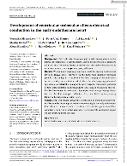Development of ventricular trabeculae affects electrical conduction in the early endothermic heart

Autor
Hamor, Peter Uriel
Janacek, Jiri
Datum vydání
2024Publikováno v
Developmental DynamicsNakladatel / Místo vydání
John Wiley & SonsRočník / Číslo vydání
253 (1)ISBN / ISSN
ISSN: 1058-8388ISBN / ISSN
eISSN: 1097-0177Informace o financování
MZ0//NU21J-02-00039
GA0//GA22-05271S
FN//V-VFN
UK//COOP
MSM//LX22NPO5104
Metadata
Zobrazit celý záznamKolekce
Tato publikace má vydavatelskou verzi s DOI 10.1002/dvdy.552
Abstrakt
Background: The ventricular trabeculae play a role, among others, in the impulse spreading in ectothermic hearts. Despite the morphological similarity with the early developing hearts of endotherms, this trabecular function in mammalian and avian embryos was poorly addressed. Results: We simulated impulse propagation inside the looping ventricle and revealed delayed apical activation in the heart with inhibited trabecular growth. This finding was corroborated by direct imaging of the endocardial surface showing early activation within the trabeculae implying preferential spreading of depolarization along with them. Targeting two crucial pathways of trabecular formation (Neuregulin/ErbB and Nkx2.5), we showed that trabecular development is also essential for proper conduction patterning. Persistence of the slow isotropic conduction likely contributed to the pumping failure in the trabeculae-deficient hearts. Conclusions: Our results showed the essential role of trabeculae in intraventricular impulse spreading and conduction patterning in the early endothermic heart. Lack of trabeculae leads to the failure of conduction parameters differentiation resulting in primitive ventricular activation with consequent impact on the cardiac pumping function.
Klíčová slova
embryonic chick heart, neuregulin, ErbB, Nkx2, 5, ventricular trabeculae,
Trvalý odkaz
https://hdl.handle.net/20.500.14178/1722Licence
Licence pro užití plného textu výsledku: Creative Commons Uveďte původ 4.0 International







